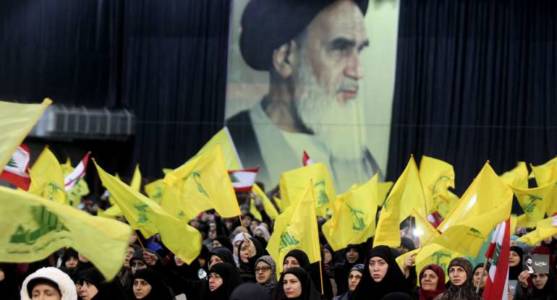
February 16, 2018, Lebanon, Beirut: Hezbollah supporters sway flags during a memorial service in honor of three high-ranking Hezbollah representatives who were killed by Israelis. (Marwan Naamani/picture-alliance/dpa/AP Images)
As a working journalist in 2007, I traveled to Nicaragua to find out why Iran had just set up shop in the country after the election of U.S nemesis President Daniel Ortega. In Managua, I found the Iranian compound in a posh neighborhood, guarded by a coterie of Nicaraguan troops. For about three days, I episodically knocked on the tall metal gates asking to interview the new Iranian ambassador. “Soon, very soon, but not today,” a polite aide always told me.
Frustrated that all I was getting to see was the peak of a limp Iranian national flag jutting up over the tall gates, I clambered up to the roof of a tall neighboring building and shot some photos of the compound’s interior, spy-like, then went off to interview Sandinista leaders and regular citizens about the Iranians encamped in their country.
Then, just as now, there was good reason for public interest and inquiry. What Iran and its terrorist proxy Hezbollah were doing at that time in Venezuela, Bolivia, and the Tri-Border Area of South America mattered on several American security and foreign policy counts. For one thing, as the 1992 and 1994 Hezbollah bombings of Jewish facilities in Argentina demonstrated, Iran and Hezbollah in America’s backyard projected a credible threat of physical retaliation against American interests and allies should saber-rattling ever go military over Iran’s nuclear program. That’s no less true today, as President Trump and various Iranian leaders trade war cries over sanctions and nukes. A U.S.-Mexico border, meanwhile, beckons just a few countries away.
For years, the main source of updated reporting about Hezbollah south of our border came from think tanks and some media, sometimes citing sources of unknown provenance. Certainly, not much ever came from the U.S. government or American intelligence agencies tracking the situation because that stuff is kind of secret.
However, an update of sorts on Hezbollah in Latin America is available from an official government source. The U.S. State Department released its annual “Country Reports on Terrorism” last month, looking back on the year 2017. The information about Hezbollah in Latin America had to be stitched together from tidbits here and there in its 340 pages (the entirety of which can be read here). What gives this information more gravitas than other sources about Hezbollah in Latin America is that State Department analysts put it in, and it survived internal review processes. Decent intelligence probably backs it up.
For starters, Hezbollah has indeed “maintained an interest in the region” through 2017, primarily “in financial and fundraising activities.” The report also hints at darker Hezbollah pursuits in the region. Countries where Hezbollah has been active in recent years include Brazil, Paraguay, Peru, Panama, Bolivia, and Argentina.
That’s one reason a find in Bolivia might give cause for alarm. The State Department report mentioned that Bolivian security services in 2017 uncovered and disrupted a “Hezbollah cache of explosive precursors in the La Paz area.”
In Peru, an October 2014 police arrest of Hezbollah-linked Lebanese national Muhammad Ghaleb Hamdar bore hallmarks of IJO presence in that country. Police found residue and traces of explosives in Hamdar’s apartment. A Peruvian court acquitted Hamdar of terrorism charges but sentenced him to six years in prison for using false documents. On October 20, the Peruvian Supreme Court overturned the acquittal, and a retrial is scheduled for this year.
As for the prospect that terrorists with Hezbollah or any other group could somehow reach the U.S. Southwest border should they choose to do so, that’s a distinct possibility even though it didn’t happen in 2017.
“The U.S. southern border remains vulnerable to terrorist transit,” the report states, adding, “ … although terrorist groups likely seek other means of trying to enter the United States.”
“Many Latin American countries have porous borders, limited law enforcement capabilities, and established smuggling routes. These vulnerabilities offer opportunities to foreign terrorist groups, but there have been no cases of terrorist groups exploiting these gaps to move operations through the region.”
Let’s hope it stays that way as President Donald Trump lays on the Iranian sanctions amid the scrap heap of the Obama nuclear deal. It may pay for the State Department and the rest of us to remember this summer’s threat from Iranian Revolutionary Guard Corps Gen. Ghasem Soleimani to President Trump after a testy exchange:
Mr. Gambler, Trump! I’m telling you that we are close to you, exactly where, you wouldn’t think that we are.
Follow Todd Bensman on Twitter @BensmanTodd
Source: PJMedia
